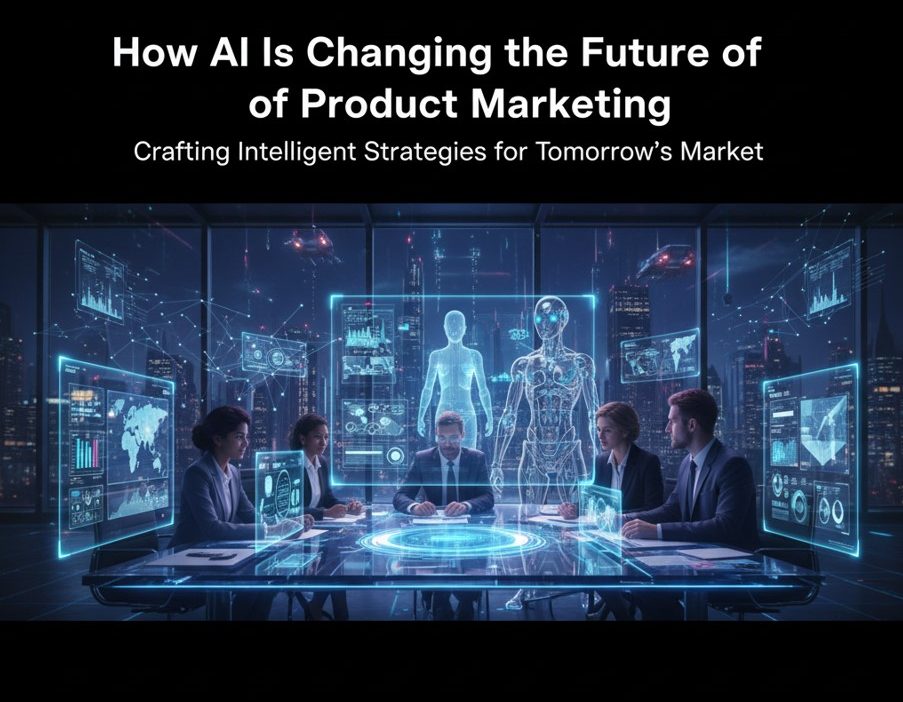In the past few years, we’ve witnessed rapid shifts in how products are developed, launched, and promoted. One of the biggest drivers of this transformation is Artificial Intelligence. As more tools and platforms incorporate AI, brands are rethinking how they approach product marketing. In this post, we’ll explore how the future of product marketing is being reshaped by AI, what key changes businesses must adopt, and how to craft a product marketing strategy that leverages AI effectively.
What Does “Future of Product Marketing” Really Mean?
The future of product marketing refers to how emerging technologies, changing consumer behavior, and new competitive pressures will reshape how companies bring products to market, communicate value, and engage customers. AI is at the core of many of these changes. It’s not just about tools doing tasks; it’s about reimagining what product marketers can do, how quickly, and with how much precision.
“AI used in marketing” isn’t a new phrase, but its depth, reach, and transformative potential are growing all the time. It’s affecting everything from what products are built to how they’re presented and how well they succeed in the market.
How AI is Already Impacting Product Marketing
Before we look ahead, let’s consider how AI is already changing product marketing today:
-
Personalization & Recommendation Engines
Companies like Amazon, Netflix, and others have long used recommendation systems to surface products. But AI now enables hyper-personalization: tailoring product messages, offers, and bundles to individual preferences, browsing behavior, and purchase history. This increases conversion rates, average order values, and customer satisfaction. -
Automated Content Creation & Scaling
AI tools can help generate ad copy, blog posts, product descriptions, social media posts, and more. This frees up human marketers to focus on creative strategy rather than repetitive content generation. AI can also optimize content for SEO, suggest variations, and test which messages work best. -
Predictive Analytics & Forecasting
AI models are being used to anticipate customer behavior, forecast trends, optimize pricing, and determine when or where to launch products. Predictive analytics also supports inventory management and demand planning. By using historical data plus real‑time signals, companies can be more proactive rather than reactive. -
Audience Segmentation & Insights
With big data, brands can now parse through large sets of customer data to identify micro‑segments and behavior patterns. AI helps in uncovering segments that might not have been obvious, clustering similar behaviors, and tailoring product positioning or messaging specifically for them. -
Conversational AI – Chatbots and Virtual Assistants
AI‑powered chatbots and virtual assistants are being used not just for customer support, but as part of the product marketing funnel: answering customer questions, guiding product discovery, upselling, guiding to demos, or helping with onboarding. This helps reduce friction and improve customer experience. -
Dynamic Pricing & Offer Optimization
AI allows companies to change prices or offers in response to demand, competitor pricing, inventory levels, or other dynamic variables. This helps maximize revenue while keeping customers engaged. Also, real‑time offers or discounting can be more precisely targeted without harming margins.
Key Trends Defining the Future of Product Marketing

Looking forward, several trends are emerging that point to how the future of product marketing will differ from what we’ve traditionally known. Here are some of the most important:
-
Hyper‑Personalization at Scale
It’s not enough to segment broadly anymore. AI will enable marketers to deliver tailored experiences for individuals. Think personalized videos, product bundles, emails, or even adaptive product pages that change based on who is visiting। -
Emotion & Context‑Aware Marketing
AI tools are beginning to detect sentiment, emotion, and context in customer behavior (both online and offline). Using these insights, product marketing can adjust messaging in real time. For example, responding differently if someone is browsing during work hours vs during leisure time, or if sentiment in reviews is trending negative vs positive. -
Autonomous Campaigns & AI Agents
In the near future, we will see more marketing campaigns that are run end‑to‑end by AI agents. These agents will define creatives, test messages, adjust targeting, allocate budgets, and report on performance — with human oversight. Efficiency gains will be huge. -
Faster Market Research & Feedback Loops
Traditional market research often takes weeks or months. AI tools are speeding that up with real‑time feedback, automated surveys, -
Cross‑Channel Integration & Omnichannel AI
Customers interact through many touchpoints: online ads, mobile apps, email, social media, and physical stores. Product marketing strategies will increasingly rely on AI to coordinate messaging, offers, and customer experience across these channels seamlessly. -
Focus on Ethics, Transparency, and Trust
As AI becomes more embedded, concerns over privacy, algorithmic bias, fairness, data use, and transparency will come prominently into product marketing strategy. Consumers expect brands to behave ethically. Clear data practices, responsible AI use, and being transparent about how personalization or pricing works will be part of the future.
Why Many Strategies Are Lagging Behind
Even though AI is powerful, many companies are not yet fully leveraging its potential in their product marketing strategy. Some common barriers:
-
Lack of Clear Vision or Governance: Many product marketing teams use AI tools in an ad‑hoc manner, without centralized oversight or a long‑term roadmap. Fluvio
-
Skill Gaps: Tools require not only training but people who understand both product marketing and data science/analytics. If the team doesn’t have this, AI can be misused or underutilized. Spekit
-
Data Quality Issues: AI is only as good as the data it is trained on. Incomplete, biased, or siloed data can lead to poor decisions, wrong product positioning, or even customer alienation.
-
Over‑automation Risks: When brands rely too heavily on automation, losing the human perspective can make messaging feel generic or hollow. Customers can detect this, which can harm trust.
-
Cost & ROI Uncertainty: Resource investment in AI tools, infrastructure, and training can be high. Without proper metrics and tracking, demonstrating return on investment can be hard.
Steps to Design a Product Marketing Strategy that Leverages AI

To stay ahead, companies need not just to use AI tools but to embed AI into the product marketing strategy in a way that adds real value. Here are the steps to build a strategy from the ground up:
-
Define Clear Objectives and KPIs
Start with what you want to achieve: improved acquisition? Higher retention? Increased upsell? Reduced churn? Lower cost per acquisition? For each objective, define specific KPIs. These will guide which AI tools or techniques are most relevant. -
Audit Data and Infrastructure
To use AI effectively, you need good data pipelines. Audit where you collect product usage data, customer feedback, purchase behaviors, interaction logs, browsing behavior, etc. Ensure the data is clean, accessible, and organized. -
Map Customer Journeys Deeply
Identify stages: awareness, consideration, decision, and post‑purchase. For each stage, think about what information, messaging, content, or interaction matters. Where can AI help: content recommendations, chatbots, re‑engagement, predictive nudges? -
Select Appropriate AI Tools & Technologies
Not all AI is the same. Choose tools aligned with your needs:-
Generative AI for content creation and creative ideation
-
Predictive analytics tools for forecasting and behavioral modeling
-
Chatbots / conversational AI for support & lead conversion
-
Personalization engines for product recommendations
-
Sentiment analysis tools for feedback, reviews, and social listening
-
-
Governance, Ethics & Compliance
Build guardrails: privacy policy adherence, transparency to customers, and data security. For AI used in personalization and offer generation, ensure fairness. Also, set up a governance system so that AI usage is consistent, ethical, and doesn’t degrade user trust. -
Pilot and Test
Before rolling out large campaigns or full integration of AI into product marketing processes, test on smaller campaigns. A/B test messaging, creatives, offers. Measure lift vs control. Use those learnings to refine the strategy. -
Invest in Skills and Cross‑Functional Collaboration
Product marketing doesn’t work in a vacuum. Collaborate with data science, product management, customer success, and UX/design teams. Also invest in upskilling your product marketing team so they understand AI basics, data‑driven decision making, and tool usage. -
Measure, Learn, and Iterate
Continuously monitor performance against KPIs. Use AI tools not just for execution, but for analysis. What messaging worked? Which segmentation is most responsive? Which channels produce the best ROI? Iterate strategy accordingly.
What the Future May Look Like: Vision for 3‑5 Years Ahead
Putting all these pieces together, here’s a speculative vision of what the future of product marketing might look like in 3‑5 years:
- Product marketing teams will be leaner but more skilled in data & AI. Routine creative tasks, segmentation, and reporting will be highly automated.
- Brand stories and messaging will be dynamic. Depending on who’s viewing (segment, behavior, location), a product page might adjust headlines, visuals, and pricing dynamically.
- Real‑time product feedback loops. AI will monitor customer usage, sentiment, reviews, and social media in real time and suggest product tweaks, messaging adjustments, or new features to product teams rapidly.
- Conversational commerce will grow. Buying via bots, voice assistants, and augmented reality assistants will become more common parts of the product purchase journey.
- Offers and pricing engines will be nimble. Dynamic offers based on customer history, device, time, and inventory will be front and center.
- More immersive experiences: AR/VR or mixed reality for product trials; AI to generate virtual try‑before‑you‑buy experiences; richer interactive content.
- Ethical personalization will be expected. Customers will expect transparency in how their data is used. Brands unable to articulate or maintain trust in personalization will lose ground.
Real‑World Examples: Brands Getting It Right
It helps to see real examples of companies using AI in product marketing strategically:
- Glance AI: Uses AI for personalized product recommendations and predictive targeting (timing, channels) to increase conversion rates. Glance
- Amazon & Shopify: Recommendation engines, dynamic bundling, and content personalization.
- Heatseeker (Australia): Using AI for rapid market research, generating real‑time consumers audience insights and experiments.
- Several product marketing teams report use of AI for productivity gains but note that embedding AI deeply in strategy and governance remains challenging.
Balancing AI and Human Element: Keep Strategy Human
While AI is changing so much, the human side must not be lost. The product marketing strategy of the future will be one that blends AI strength with human judgment, creativity, empathy, and ethical perspective. Some key reminders:
- AI can support but not fully replace creative storytelling, brand voice, or emotional connections.
- Humans must oversee AI‑driven messaging to ensure messaging remains aligned with brand values.
- Creativity, serendipity, and intuition still matter—especially in distinguishing brands in crowded markets.
- Ethical judgment on how data is used, privacy, and transparency must be human‑led.
Action Plan: Adapting Your Product Marketing Strategy for an AI‑Driven Future
Here’s a checklist to help product marketing teams adapt and prepare:
| Step | What to do | Why it matters |
|---|---|---|
| Audit existing tools and workflow | Identify where manual, repetitive work occurs | Automate what can be automated to free human resources |
| Define AI KPIs | Put measurable goals behind AI initiatives (e.g., personalization lift, time saved, cycles of iteration) | Ensures accountability and clear ROI |
| Build data foundation | Centralize customer and product data; clean and integrate sources | Enables AI models to function well |
| Choose the right vendors/platforms | Match tool capabilities with your needs (not just trendy tools) | Avoids wasted budget or tool clutter |
| Pilot experiments | Try AI in small campaigns before scaling | Minimizes risk and allows learning |
| Train team | Provide AI literacy, data skills, and ethical training | Helps adoption and prevents misuse |
| Monitor and review regularly | Check performance, survey customer feedback, adjust strategy | Keeps strategy aligned and relevant |
Conclusion
The future of product marketing is being rewritten by AI. What was once manual, slow, and broad is becoming more automated, fast, and deeply personalized. For product marketers, this shift means not just adopting new tools, but rethinking strategy: how you understand customers, how you message, how you measure, and how you iterate.
A well‑designed, AI‑infused product marketing strategy will allow businesses to shine in ways that weren’t possible before—predicting demand before it arises, tailoring every message to individuals, speeding up product feedback cycles, and creating experiences rather than just pushing products. But success depends on maintaining the human touch: creativity, values, empathy, ethics.
If you’re building or refining your product marketing strategy today, ask yourself:
- Are your goals aligned with what AI can uniquely enable?
- Is your data infrastructure ready?
- Are you measuring the right outcomes?
- Are you keeping the customer experience human, even as you scale?
Answering those questions will help ensure that you don’t just keep up, but lead in the future of product marketing.
FAQ: How AI Is Shaping the Future of Product Marketing
1. What is the future of product marketing?
The future of product marketing is increasingly driven by artificial intelligence, automation, and data-driven personalization. AI tools are enabling marketers to create tailored customer experiences, run predictive campaigns, and generate insights faster and more accurately than ever before. The future will involve more real-time decision-making, hyper-personalized content, and omnichannel integration.
2. How is AI used in product marketing today?
AI is used in product marketing in several ways:
- Personalized product recommendations
- Automated ad copy and content creation
- Predictive customer behavior modeling
- Dynamic pricing and offer optimization
- Sentiment analysis of customer reviews
- Chatbots and AI assistants for lead nurturing
These tools help marketers streamline processes, improve targeting, and increase ROI.
3. What are the benefits of using AI in a product marketing strategy?
Integrating AI into a product marketing strategy provides several key benefits:
- Faster decision-making through predictive analytics
- Better customer segmentation and targeting
- Higher personalization at scale
- Improved content generation and testing
- Real-time feedback and performance tracking
Ultimately, AI helps create more effective and efficient marketing campaigns.
4. Will AI replace human marketers in the future of product marketing?
AI will not replace human marketers but will augment their capabilities. While AI can handle data analysis, automation, and content generation, human creativity, strategic thinking, empathy, and ethical judgment are still essential to building meaningful customer relationships and brand narratives.
5. How can businesses start using AI in their product marketing strategy?
To begin using AI in your product marketing strategy, follow these steps:
- Define goals (e.g., personalization, automation, ROI improvement)
- Audit your data infrastructure
- Select AI tools that align with your marketing needs
- Pilot small experiments and test outcomes
- Train your team to work alongside AI platforms
- Monitor and optimize AI performance continuously
6. Which industries benefit most from AI in product marketing?
AI-driven product marketing is beneficial across industries, including:
- Retail & E-commerce: Product recommendations and dynamic pricing
- Healthcare: Personalized patient education and appointment reminders
- Finance: Predictive modeling and customer segmentation
- SaaS & Tech: Lead scoring and onboarding automation
- Hospitality: Personalized travel offers and guest experience optimization
7. What AI tools are commonly used in product marketing?
Some widely-used AI tools for product marketing include:
- HubSpot and Salesforce Einstein (CRM & marketing automation)
- ChatGPT or Jasper (content generation)
- Google AI and Meta Advantage+ (ad targeting)
- Dynamic Yield, Optimizely (personalization & testing)
- Hootsuite Insights, Brandwatch (sentiment analysis & social listening)
8. How does AI help with market research in product marketing?
AI accelerates market research by:
- Analyzing social media sentiment
- Automating customer surveys
- Tracking competitor trends
- Detecting emerging patterns in real-time
- Segmenting audiences based on behavioral data
This allows marketers to react faster and make more informed decisions when planning or adjusting campaigns.
9. Is AI safe and ethical to use in product marketing?
AI use in product marketing raises ethical concerns such as data privacy, bias, and transparency. It’s essential for businesses to:
- Ensure compliance with data protection laws (e.g., GDPR)
- Be transparent with consumers about data use
- Monitor AI outputs for bias or inaccuracy
- Balance automation with human oversight
10. What is the long-term impact of AI on modern businesses’ marketing teams?
Over time, modern businesses will rely more heavily on AI to handle repetitive tasks, analyze data, and optimize campaigns. As a result, marketing teams will evolve to focus more on strategy, creative innovation, customer experience, and AI oversight. This shift will require ongoing training and collaboration between marketers, data scientists, and tech teams.
Learn more about: How to Align Marketing with Product Development Teams





